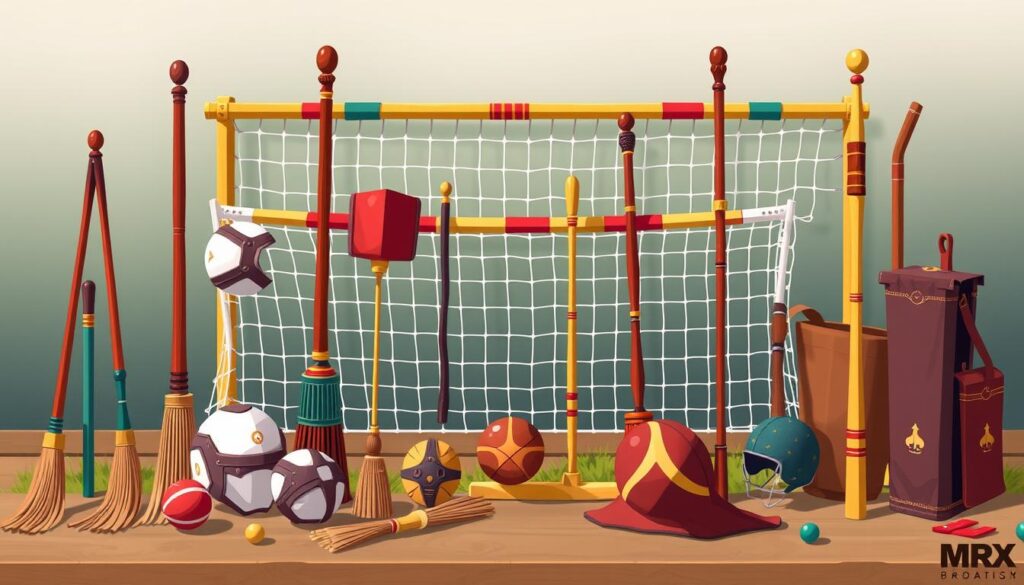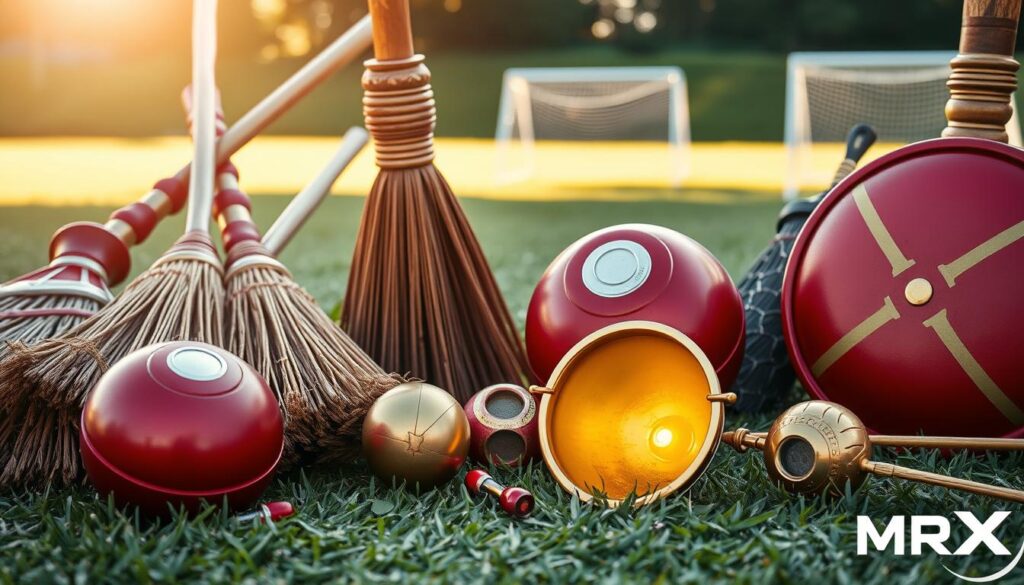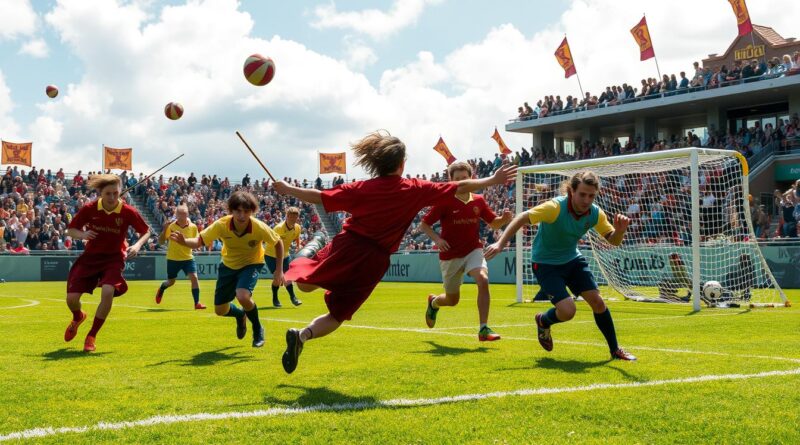Quidditch Rules and Regulations – Learn to Play!
Imagine flying on a broomstick, feeling the wind, and hearing your team cheer. Quidditch, from Harry Potter, is now a real sport. It’s about teamwork and fun. Whether you’re an athlete or new, learning quidditch is exciting.
In this article, we’ll cover quidditch basics. You’ll learn the rules and how to play. This way, you can join in and enjoy this thrilling sport.
Key Takeaways
- A quidditch team can have up to 21 players, each with a role.
- Only seven players can be on the field at a time. This includes a Keeper, three Chasers, two Beaters, and one Seeker.
- Scoring with the Quaffle gets you 10 points. Catching the Snitch earns 150 points and ends the game.
- The Snitch Runner is released after 17 minutes. Seekers can join at the 18-minute mark.
- Remember key players like Dragomir Gorgovitch and Ludo Bagman. They add depth to your discussions.
Introduction to Quidditch
Quidditch started in the Harry Potter series, winning fans with its creative gameplay and magical touches. It has grown into a real-world sport loved by many. In this introduction to quidditch, players learn what is quidditch and how it mixes sports with strategy in a fun way.
The game has two teams with seven players each. They try to score by throwing the Quaffle through hoops while defending against others. Each team has three Chasers, two Beaters, one Keeper, and one Seeker. Chasers get 10 points for each goal, and the Seeker gets 150 points for catching the Golden Snitch, ending the game.
Knowing the basics of quidditch makes the game more fun for everyone. The game is played on a 60 by 36 yard field, lasting 30 to 40 minutes. There are two Bludgers that try to mess with the players. Plus, it welcomes players from all walks of life, making it a fun and competitive sport.
Quidditch has a long history, starting in 2005 and now played worldwide. It’s popular in places like Canada, Australia, and the UK. The name change to quadball in 2022 shows how it’s still growing and exciting.
Understanding the Game Structure
Quidditch is a fast-paced sport with a unique game structure. Each match pits two teams against each other, each with up to 21 players. But only seven players are on the field at a time.
This team makeup includes three Chasers, one Keeper, two Beaters, and one Seeker. This balance ensures that all players’ skills are used during the game.
Teams and Players
Teams in quidditch are built for both competition and teamwork. Each role is crucial:
- Chasers: They score goals with the Quaffle, a deflated volleyball worth 2 points each.
- Beaters: They manage Bludgers and protect their teammates from harm.
- Keeper: They guard the team’s goal, stopping the opposing Chasers.
- Seeker: They chase the Golden Snitch for an extra 30 points.
These roles make the game engaging and strategic. They encourage teamwork and communication among players.
Game Duration
Quidditch matches last between 20 to 30 minutes. The game starts with a 10-minute interval before the Snitch is released. This time pressure affects strategies and urgency.
Players must manage their actions well to win. This makes each match highly competitive.
Quidditch Game Guidelines
Learning the quidditch game guidelines is key for both new and experienced players. The main goal is to score by throwing the quaffle through the opponent’s hoops. You also need to defend your own hoops. Each player has a role that helps the team win.
A team has seven players: three chasers, two beaters, one keeper, and one seeker. Chasers get ten points for each goal. The seeker catches the snitch for 150 points, ending the game. Players must hold their broomsticks at all times, showing the need for balance and agility.
Rules for fair play are strict. The keeper protects the goal, and only the seeker can catch the snitch. Players must avoid bludgers, as they can’t hit the seeker or snitch.
Every player is important, from calling timeouts to stopping play. Referees start the game, release the snitch, and handle fouls. Knowing these roles helps teammates work better together.
With these quidditch game guidelines, players can improve their game strategy. This leads to better teamwork and success on the field.
Positions in Quidditch
Knowing the different roles in quidditch is key for all players. Each role adds something special to the team’s game. Understanding these roles can really improve how well the team plays together.
Chasers
Chasers aim to score by throwing the Quaffle into the opponent’s hoops. Each goal is worth 10 points. It’s all about teamwork; Chasers need to work with Beaters and Keepers for great plays.
Keepers
The Keeper’s job is to defend the hoops and stop the other team from scoring. In Quidditch Champions, Keepers can make rings that speed up teammates. This helps the team move faster towards the goal.
Beaters
Beaters control the Bludgers, which can harm opposing players. They summon Bludgers to distract Chasers or Seekers. Every team needs a Beater to keep the game balanced.
Seekers
Seekers chase after the Golden Snitch to win 30 points in Quidditch Champions. Catching the Snitch can change the game’s direction. It’s a role that needs quick thinking and strategy.
Quidditch Rules and Regulations
Quidditch, a sport born in 2005, has rules that make the game fair and fun. Knowing the official quidditch rules is key for players and fans. It helps keep the game respectful and structured for everyone.
Official Quidditch Rules Overview
The game’s rules are the heart of Quidditch. A team has seven players: one Seeker, one Keeper, two Beaters, and three Chasers. The goal is to score by throwing the Quaffle through hoops of different heights (2m, 1.4m, and 1m). Each hoop is worth ten points.
Catching the Golden Snitch, worth thirty points, can change the game. It rewards teams for their strategy.
Field Dimensions
Knowing the field’s dimensions is key for setting up the game. The field has lines and a center mark for organization. The hoops are at different heights, offering various scoring chances.
Equipment Rules
Following the equipment rules is important for safety and fair play. Teams must wear the same color jerseys. Players should wear tennis shoes, and jewelry or dangerous items are banned.
Beaters use bludgers to disrupt the opposing team. A coin toss decides who attacks first. Knowing these rules makes the game better and reduces penalties.

| Aspect | Description |
|---|---|
| Team Composition | 7 players: 1 Seeker, 1 Keeper, 2 Beaters, 3 Chasers |
| Scoring | 10 points per goal; 30 points for the Golden Snitch |
| Hoop Heights | 2m, 1.4m, 1m |
| Field Layout | Midfield lines, sidelines, backlines, center mark |
| Footwear | Tennis shoes recommended; no sandals or combat boots |
| Jewelry Policy | No jewelry or dangerous items allowed |
The Quidditch Scoring System
Understanding the quidditch scoring system is key for players and fans. Points are mainly earned by throwing the Quaffle through the opposing team’s hoops. Each successful shot gets the team ten points.
This shows how each player helps their team score. It’s a dynamic game that requires teamwork and strategy.
How Points are Scored
Quidditch matches have two teams with seven players each. The Chasers throw the Quaffle to score. They aim to throw it through the opponents’ hoops.
This strategy helps the team get points. Each successful shot adds ten points to their score. It greatly affects the game’s outcome.
Impact of Catching the Snitch
Catching the Snitch is a big win, giving the Seeker’s team 150 points. It ends the game. While scoring through hoops is crucial, the Seeker’s performance often decides the game.
The game requires teamwork and quick thinking. Catching the Snitch is the key to winning.
| Action | Points Awarded |
|---|---|
| Throwing the Quaffle through a hoop | 10 points |
| Catching the Golden Snitch | 150 points |
The quidditch scoring system combines strategy and skill. It shows how teams can earn points. It also highlights the importance of teamwork in the game.
Understanding Bludgers
In quidditch, bludgers add excitement and strategy to the game. They are enchanted balls that try to knock players off their brooms. Only beaters can handle them, using them for both offense and defense.
Mastering bludger gameplay is key to excelling in the sport. It adds complexity that every player must understand.
Role of Bludgers in Gameplay
Two bludgers are active in each match, controlled by the team’s beaters. This setup leads to intense moments where strategy is crucial. Beaters use bludgers to target opposing chasers, forcing them to drop the quaffle.
Teams must develop tactics to protect their chasers while disrupting opponents. Understanding bludgers is essential for this.
Player Penalties Related to Bludgers
Players face challenges from bludgers, making penalties in quidditch critical. If a player drops their broom due to a bludger hit, a foul can be called. This results in immediate consequences for their team.
The opposing team’s keeper will defend against a free shot taken by a chosen chaser. This adds pressure to the team that incurred the penalty. Recognizing these scenarios helps players stay disciplined and improve their game.
| Aspect | Description |
|---|---|
| Bludger Control | Only beaters are allowed to possess and throw bludgers at opposing players. |
| Impact of a Hit | If a chaser is hit, they lose possession of the quaffle and must return to their goal post. |
| Penalty Consequences | The opposing team earns a free shot against the keeper if a foul occurs due to losing control of the broom. |
| Team Strategy | Coordination among beaters is necessary to effectively manage the three bludgers during the game. |
Fouls and Penalties in Quidditch
Quidditch is a thrilling sport that mixes strategy, teamwork, and skill. It’s vital for players to follow the rules and regulations to keep the game fair. Quidditch fouls happen when players break rules, like bad broomstick use or rough play. Knowing these fouls is key for everyone playing.
There are different kinds of rule breaks and their penalties. For example, some fouls mean a player must sit out for two minutes. Players must stay 3 yards away from the opposing team during a free throw. Also, entering the wrong zone while shooting can lead to penalties, keeping players in their spots.
- Percentage of female players required on the field during game time to avoid a forfeit: 40%
- Points awarded for scoring a goal with the Quaffle: 10 points
- Points awarded for scoring a goal with the Snitch: 30 points
- Consequence for playing in a potentially dangerous or reckless manner: Unsportsmanlike penalty or ejection
- Number of players on each team: 7 players (1 Keeper, 3 Chasers, 2 Beaters, 1 Seeker)
Bludgers can make the game tricky; players hit by them might get hurt if they’re not careful. Teamwork helps avoid quidditch fouls and injuries. With smart strategies, players can have fun matches with fewer penalties. Playing with respect for the rules makes the game enjoyable for all.
Field Setup for Quidditch
Setting up a quidditch field needs specific measurements and layouts. This ensures a fair and competitive game. Knowing the standard field dimensions and goal post placement is key. This guide will help players and organizers set up for the best gameplay.
Dimensions and Layout
A quidditch field is at least 36 yards by 66 yards. The field’s edges should match the back of the stands. This creates clear limits for the game. Roles in the game are important, so a well-defined space is crucial. Here are the main field dimensions:
| Field Measurement | Dimension (yards) |
|---|---|
| Length | 66 |
| Width | 36 |
Goal Post Setup
Setting up the goal posts correctly is vital for scoring. The posts must be 10 feet high and 3 feet in diameter. They should be 8 feet apart. Here are the goal post dimensions:
| Part | Dimension |
|---|---|
| Height | 10 feet |
| Diameter | 3 feet |
| Distance Between Posts | 8 feet |
Quidditch Equipment Rules
Knowing the quidditch equipment regulations is key for any player or team. Everyone needs the right gear for safety and fairness. We’ll look at the equipment needed for quidditch in detail.
A quidditch team has seven players: one seeker, one keeper, three chasers, and two beaters. Each role needs special gear. For example, keepers and chasers wear headgear and padding to protect against bludgers.
The game uses three main balls: the quaffle, bludgers, and the golden snitch. These balls must meet size and material standards for fair play.

Broomsticks are crucial in quidditch. They must be light for easy flying. Players should wear gear that fits well and is safe for the game.
| Equipment Type | Specifications | Purpose |
|---|---|---|
| Quaffle | Size: 33 cm, Color: Red | Used for scoring points (10 points per goal) |
| Bludgers | Size: 24 cm, Material: Slightly deflated dodgeball | Disrupt gameplay and knock players out temporarily |
| Golden Snitch | Size: 12 cm, Color: Gold | Concludes the game and awards 30 points |
| Broomsticks | Lightweight, no specific brand requirement | Enables players to fly and maneuver on the field |
| Protective Gear | Includes helmets, pads, and gloves | Ensures player safety during matches |
Following these rules keeps the game exciting and safe. Each piece of gear is vital. So, players must have the right equipment before playing.
Starting and Ending a Quidditch Game
Knowing how to start and end a quidditch game is key for players and fans. The rules for starting and stopping a match are clear. They keep the game exciting and fair for everyone.
Game Start Procedures
The game starts with a clear signal from the referee. Players stand ready near their hoops. Then, the referee throws the Quaffle, and the game is on.
The referee’s whistle is the official start. It tells players to get ready and show their competitive spirit.
Determining Game End
A quidditch game can end in a few ways. It ends when one team reaches 100 points or when time runs out. Catching the Golden Snitch also ends the game, giving the catching team 150 points.
This scoring system makes the game thrilling. Catching the Snitch can change the game’s outcome. Games can last a long time, showing the importance of knowing when to end.
Roles of Referees in Quidditch
Referees in quidditch are key to making sure games run smoothly and fairly. They keep the game moving and enforce the rules. Their job is to make sure players follow the game’s standards.
Every game has a Head Referee who watches over the game and makes big calls. They are helped by Assistant Referees placed around the field. These officials watch for fouls and handle any disputes that come up.
The team of officials also includes special roles:
| Referee Role | Responsibilities |
|---|---|
| Head Referee | Oversees the game, enforces rules, and makes final decisions on calls. |
| Goal Referee | Judges whether the quaffle passes through the goal hoops. |
| Timekeeper | Keeps track of game time and manages pauses and intervals. |
| Scorekeeper | Records scores and tracks amendments to game rules. |
| Assistant Referees | Support the Head Referee by monitoring player actions and communicating fouls. |
The IQA sets rules for who can be a referee. Anyone officiating at official events needs a special IQA certification. This shows they know the game well. Referees also get training to help them make the right calls.
Referees are crucial for keeping quidditch competitive and fair. Their work makes the game better and helps players value teamwork and sportsmanship.
Strategies for Successfully Playing Quidditch
Effective quidditch strategies are key to success on the field. Team coordination is at the heart of every play, from scoring to defending. Each player must know their role to help the team win.
Team Coordination
Good team coordination makes the game better. Team members should follow these strategies:
- Constant Communication: Everyone needs to talk clearly, so everyone knows the plan.
- Position Awareness: Knowing where everyone is helps make better decisions during the game.
- Frequent Practice: Regular practice builds team chemistry, essential for smooth plays.
Mastering these points can greatly improve a team’s chances of winning.
Individual Roles and Responsibilities
Each player has a unique role for the best performance. Here are the main roles:
- Chasers: Their main job is to score by throwing the quaffle through the opponent’s goal.
- Keepers: They defend against scoring attempts and block Chasers from scoring.
- Beaters: They use skills like “Bludger Damage I-III” to protect teammates and target opponents.
- Seekers: Their goal is to catch the snitch, ending the game and earning big points.
Knowing these roles and responsibilities helps teams work together better and win more games.
Common Misconceptions about Quidditch
Quidditch, known from the Harry Potter series, has many misconceptions. Fans often think it’s just a fictional game, not realizing thousands of people play it in real life. They also believe it’s too dangerous, with many injuries and safety concerns.
Many think Quidditch games always end with the Golden Snitch being caught. But games can last over an hour. Catching the Snitch is exciting, but it doesn’t always mean a team wins, as shown in the Harry Potter books.
- Contrary to popular belief, Quidditch allows for various forms of player contact including tackling and wrapping.
- Players typically engage in extensive fundraising activities to support their teams—something often overlooked by outsiders.
- Many players enjoy friendly interactions post-game, debunking the myth that Quidditch fosters bitterness among competitors.
- Leagues such as Major League Quidditch operate independently from the Harry Potter franchise, focusing on professional play and organization.
Learning about Quidditch’s real nature helps clear up these myths. It shows a sport that values teamwork, athleticism, and community. By joining a local or university team, you can see for yourself how exciting and rewarding Quidditch can be.
Getting Involved in Quidditch
Are you ready to dive into the world of quidditch? There are many ways to get involved. You can go from watching to playing, deepening your connection with the sport and its community. Joining a local team or starting your own club can be very rewarding.
Joining a Team
Looking for a local quidditch team is a great first step. Universities and communities often have teams for players of all levels. To join, try attending practice sessions to meet players and learn their routines. Here’s how to start:
- Look for teams in your area on social media or sports listings.
- Go to open practices to see how the team works together.
- Talk to current members about their experiences and how you can help.
- Join introductory sessions to improve your skills and knowledge.
Starting Your Own Quidditch Club
If you can’t find a team, think about starting your own club. This can help you develop leadership skills, teamwork, and a sense of community. Here’s how to start a club:
- Find people who are as excited about quidditch as you are.
- Find a good place for practices and games.
- Register your club with local sports groups for resources.
- Use social media to attract new members and promote events.
Building a quidditch community takes time, but it’s worth it. It creates lasting friendships and a deeper appreciation for the sport.
| Aspect | Joining a Team | Starting a Club |
|---|---|---|
| Community | Established players | Build your own |
| Accessibility | Often easier to find | Requires initiative |
| Skill Development | Guided by experienced players | Self-driven learning |
| Team Dynamics | Ready-made team culture | Develop your own culture |
Joining quidditch teams or starting clubs opens doors to socializing, improving your skills, and personal growth. Dive into the adventure of quidditch and enjoy every moment.
Resources for Quidditch Players
Quidditch is a thrilling sport that needs knowledge and resources to play well. Players at all levels need access to key materials and communities to get better. Knowing where to find essential quidditch resources, like rulebooks and online communities, can make your experience better and connect you more to the sport.
Where to Find Rulebooks
Finding quidditch rulebooks is key for players wanting to understand the game. These rulebooks give detailed guidelines on gameplay, fouls, and team structures. Here are some reliable sources to find essential rulebooks:
- Official Quidditch organizations’ websites often have downloadable PDFs of current rulebooks.
- Local quidditch leagues may provide printed copies to players and coaches.
- Community forums and online platforms often share links to updated rulebooks, making them easier to access for everyone.
Online Communities and Forums
Being part of online quidditch communities builds camaraderie among players. These platforms are great for sharing experiences, improving skills, and asking questions. Here are some options:
- Social Media Groups: Platforms like Facebook have groups dedicated to quidditch where players can join discussions and find teammates.
- Online Forums: Websites like Reddit feature threads focusing on quidditch strategies and news.
- Discord Channels: Many quidditch teams use Discord to communicate and organize practice sessions.
Joining these online quidditch communities not only helps in finding resources but also creates a supportive environment for players. These platforms make it easy to connect with fellow enthusiasts, share tips, and improve your gameplay.
| Resource Type | Examples | Access Method |
|---|---|---|
| Rulebooks | Official PDFs, Local League Copies | Download, Request from League |
| Community Platforms | Facebook Groups, Reddit, Discord | Join or Subscribe |
| Coaching Resources | Videos, Tutorials | YouTube, League Websites |
Conclusion
We’ve looked into the rules and rules of quidditch, a sport full of excitement and challenges. It has different roles like chasers, beaters, and seekers. The Snitch also plays a big role in scoring.
Looking at injury stats, we see how important safety is. This is even more true for male and female athletes. They face different risks.
Thinking about quidditch, we see it’s all about teamwork, strategy, and staying fit. It welcomes players from all walks of life. With over 25,000 players worldwide, it’s a growing sport.
But, it still faces issues like making sure everyone feels included and safe. Despite these, the sport is full of joy and community.
If you want to play quidditch, now’s the time! Look for a local team or start your own club. It’s a thrilling sport that brings people together.
So, let’s all get excited, share what we know, and build a community. In the world of quidditch, everyone can find joy and success.
FAQ
What is quidditch?
Quidditch is a sport that combines athleticism and strategy. It’s played on broomsticks, inspired by Harry Potter. Now, it’s enjoyed by players worldwide.
How many players are on a quidditch team?
A quidditch team has seven players. This includes three Chasers, one Keeper, two Beaters, and one Seeker. Teams can have up to 21 players.
How long does a quidditch game last?
Quidditch games last 17 to 20 minutes. This is before the Snitch is released. The game ends if the Snitch is caught.
What is the main objective in quidditch?
The main goal is to score by throwing the quaffle through hoops. Protecting your hoops is also key. Catching the Snitch adds extra points and can end the game.
How does scoring work in quidditch?
Scoring 10 points is achieved by throwing the quaffle through hoops. Catching the Snitch gives 30 points and ends the game.
What role do bludgers play in the game?
Bludgers disrupt the game by hitting players. This makes them drop their brooms and leaves them out for a while. To get back in, players must tag a hoop.
What are common fouls in quidditch?
Common fouls include rough play and bad broomstick use. These can lead to penalties. Players must follow the rules to help their team.
What are the essential dimensions for a quidditch field?
A field should be 100-150 meters long and 60-70 meters wide. Goalposts are 3 meters tall, in sets of three at each end.
What equipment is needed to play quidditch?
You need a quaffle, two bludgers, and a golden snitch. Brooms and protective gear are also essential for safety.
How can I get involved in quidditch?
Join local clubs, leagues, or start your own team. Resources help you find clubs and get started.
Can anyone play quidditch?
Yes! Quidditch welcomes everyone. It’s for all ages and skill levels, promoting community and teamwork.
What online resources are available for quidditch players?
There are many resources online. Forums, rulebooks, and community groups help players connect and learn more.
Source Links
- How to play
- A blagger’s guide to Quidditch | Wizarding World
- Harry Potter 101: Quidditch part one | Wizarding World
- Quidditch (real-life sport)
- IQA Rulebook 2018-20 – Oct 2018
- Quidditch at Rutgers: Far from its Magical Roots
- Quidditch Rules
- Harry Potter: What Are The Rules of Quidditch?
- Quidditch Champions: All Positions, Explained
- Quidditch
- Quidditch Rules: How To Play Quidditch
- Quidditch
- Quidditch
- Quidditch is stupid – Matthew Dicks
- Quidditch rules
- Real-life Quidditch: No flying, but lots of strategy, tackling and athleticism
- How to Play Muggle Quidditch (with Pictures) – wikiHow
- Quidditch IC Rules – Mischief Managed
- Microsoft Word – Quidditch Rules
- Harry Potter: Quidditch Champions Review – IGN
- FAQ | Harry Potter: Quidditch Champions
- What’s Wrong With Quidditch? – (Fantasy Game Design Studies)
- Referees | QuadballUK
- Quidditch: An Introduction to This Actual Sport (Yes, It’s Real)
- Microsoft Word – Quidditch-Handbook-FOUND-SOME-TYPOS-BUT-SUPPOSEDLY-FINAL-VERSION.docx
- Harry Potter Quidditch Champions: Tips For Playing Beater
- Just because I play Quidditch doesn’t mean I’m a nerd
- Analyzing Fictional Games: Quidditch
- Can You Have Quidditch without Harry Potter?
- Harry Potter – mechanics for quidditch? | Tabletop Roleplaying Game Design
- Quidditch Rules – Witchcraft and Wizardry
- Nexplore Quidditch
- Quidditch Regulations
- INJURIES IN QUIDDITCH: A DESCRIPTIVE EPIDEMIOLOGICAL STUDY
- Quidditch’s Gender Inequality Problem



